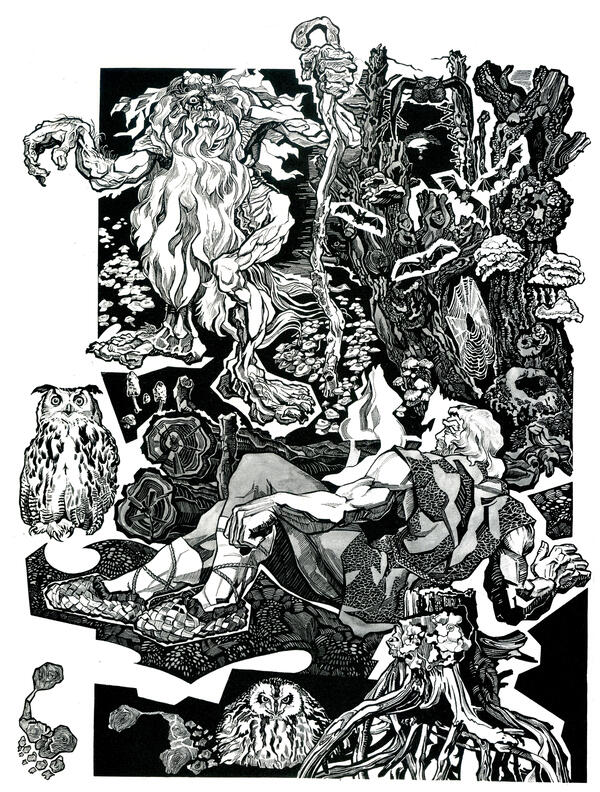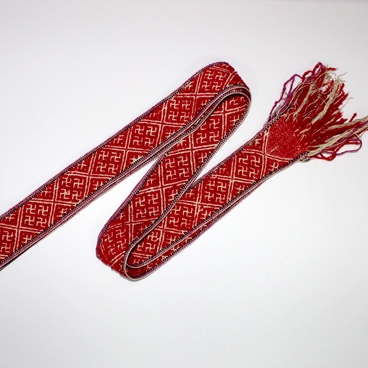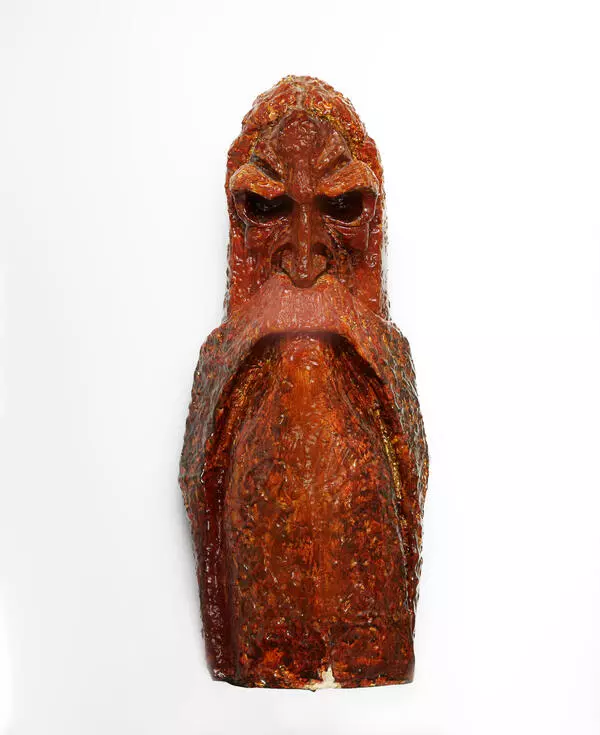The engraving created by Vitaly Nikolaevich Onkov presents one of the Komi-Permyak mythological scenes. Pera the bogatyr (epic hero), takes a rest near a smoldering fire at night. He is guarded by the forest creatures: an owl and an eagle owl. An enormous old leshy (forest spirit), leaning on a crooked staff, emerges from the depths of the forest, and in front of him are bats fluttering away. The picture is executed in black gouache as well as green and yellow watercolors. It was donated to the museum by the author in 1993.
Vitaly Nikolaevich Onkov is an original Komi-Permyak graphic artist, painter, sculptor, graduate of the Art and Graphic Department of the Leningrad Pedagogical Institute named after Alexander Herzen, member of the Union of Artists of Russia. He was one of the first to turn to Komi-Permyak folklore, he studied pagan mythology and its co-existence with Christianity. Vitaly Nikolayevich provided a visual image to the oral folk poetry, embodied mythical creatures and legendary heroes on paper, in clay and wood.
The characters Kudym-Osh and Pera, father and son, are central in the artist’s work, he uses them in his easel paintings, sculptures, and book illustrations, such as in the book “The Tale of Kudym-Osh and Pera the Bogatyr” by Alexey Domnin. A hero of the Northern Komi-Permyak epos, Pera is a hunter and a fisherman, who lives in parma (the taiga of Komi land), and he is always accompanied by an owl and a lynx. He is wise and strong, protecting the weak and fearing no one. Pera knows the taiga well and competes in wit with Leshy — Vörsa in the Komi language. Vörsa tries to kill Pera at night while the bogatyr is asleep, but each time the latter tricks Leshy and puts a tree trunk in his stead. The artist depicts Pera the hunter in the central part of his work, emphasizing his superiority and supremacy in the mythological pantheon.
The mythological theme contributes to the artist’s efforts to capture the beauty and grandeur of the taiga region, and Vitaly Onkov depicts its nature in a very thoughtful way. His trees, birds, animals appear to be conscious observers of life, while the forest and the water spirits are able to frighten the beholder. The artist succeeded in telling a complex story within a compact composition, recreating the figures of the characters and the landscape rich in details.
Vitaly Nikolaevich Onkov is an original Komi-Permyak graphic artist, painter, sculptor, graduate of the Art and Graphic Department of the Leningrad Pedagogical Institute named after Alexander Herzen, member of the Union of Artists of Russia. He was one of the first to turn to Komi-Permyak folklore, he studied pagan mythology and its co-existence with Christianity. Vitaly Nikolayevich provided a visual image to the oral folk poetry, embodied mythical creatures and legendary heroes on paper, in clay and wood.
The characters Kudym-Osh and Pera, father and son, are central in the artist’s work, he uses them in his easel paintings, sculptures, and book illustrations, such as in the book “The Tale of Kudym-Osh and Pera the Bogatyr” by Alexey Domnin. A hero of the Northern Komi-Permyak epos, Pera is a hunter and a fisherman, who lives in parma (the taiga of Komi land), and he is always accompanied by an owl and a lynx. He is wise and strong, protecting the weak and fearing no one. Pera knows the taiga well and competes in wit with Leshy — Vörsa in the Komi language. Vörsa tries to kill Pera at night while the bogatyr is asleep, but each time the latter tricks Leshy and puts a tree trunk in his stead. The artist depicts Pera the hunter in the central part of his work, emphasizing his superiority and supremacy in the mythological pantheon.
The mythological theme contributes to the artist’s efforts to capture the beauty and grandeur of the taiga region, and Vitaly Onkov depicts its nature in a very thoughtful way. His trees, birds, animals appear to be conscious observers of life, while the forest and the water spirits are able to frighten the beholder. The artist succeeded in telling a complex story within a compact composition, recreating the figures of the characters and the landscape rich in details.




